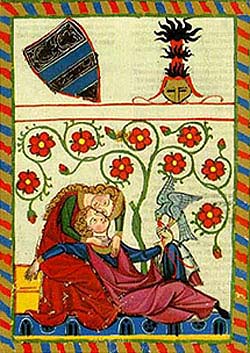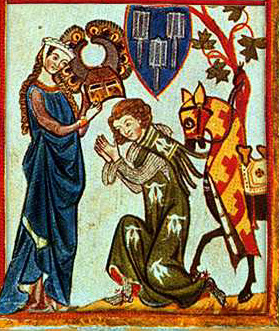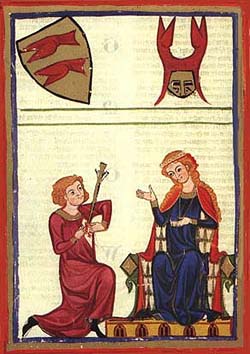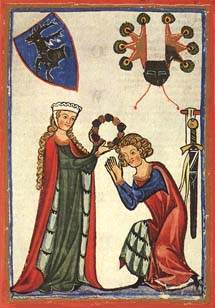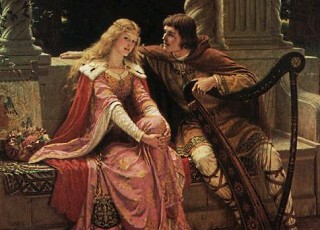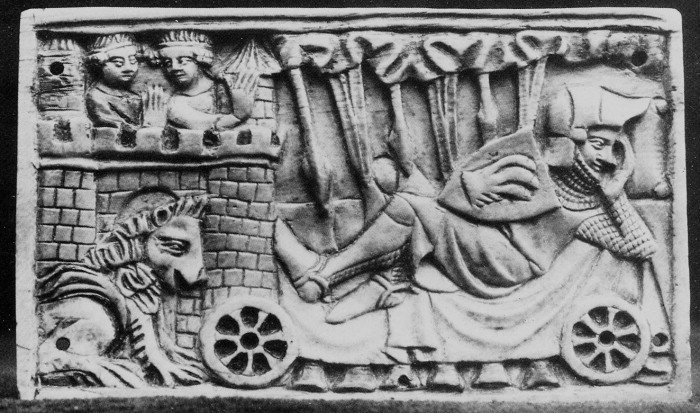
A lot of shit got slung at me last week about making comparisons of chivalry being an antiquated social extension of the Feminine Imperative. I’ve written about the concept of chivalry and its impact on the intergender landscape of today, but as I read through certain select comments in Sanitizing the Imperative and after reading the misconception about chivalry on other blogs I felt the idea of chivalry deserved a bit more attention.
Over the course of my travails in the manosphere one common misperception I read a lot coming from well meaning red pill men, as well as the predictable blue pill white knight is this broken and romanticized notion of what chivalry means to them and should mean for everyone else expected to “play by the rules.” I originally touched upon the convenient use the modern Feminine Imperative has made in making appeals to anachronistic idealisms like chivalry and honor in The Honor System. I then revisited this in a bit more detail after the Concordia shipwreck with the women and children first debate even staunch jezebelers couldn’t resist in Chivalry vs. Altruism:
Chivalry is simply one of many ideologies that was subsumed by westernized romanticism. Chivalry also applied toward things such as not hitting a man while he wasn’t looking or attacking a blatantly undefendable, inferior or even a respected foe. It was originally intended as a code of etheics determined by the Roman Catholic church to control the otherwise lawless and violent natures of soldiers and knights who, understandably, had a tendency for brigandism in the middle ages. What passes for most people’s understanding of chivalry is actually a classic interpretation and bastardization of western romanticisim and the ideologies of ‘courtly love’, which ironically enough was also an effort by the women of the period intended to better control the men of the early and high Renaissance. Essentially it amounted to a taming of the over-dominating masculine influence of the time by laying out a system of prescribed appropriate conditions necessary to satisfy a womans access to her intimacy.
You’ll have to forgive me for indulging in a history lesson for today’s post, but it is necessary. What I find most common in men’s interpretation of chivalry is an almost Disneyesque mental return to knightly virtues of the past that only ever existed in films like Excalibur. My first amazement is that concept of romanticized chivalry have endured as long as they have. This is not due to some provable merit, but rather that the expectations of the more useful aspects of chivalry have benefitted the Feminine Imperative for so long that they’ve become ubiquitous expectations of men – even while coexisting beside a feminism that actively derides them.
So bear with me while we return to the foggy days of medieval Western Europe to search for the true roots of chivalry.
Origins of Chivalry
The year is around 1060 and over the last 100 years or so (i.e. the ‘dark ages’) a feudal system of moneyed landowners and their personal militias have made a mess of things. In spite of the best efforts of containment and control by the Holy Roman Empire, constant violence and sporadic wars amongst these small states have led to a breakdown in the fabric of society. Brigandism and outright barbarism are common amongst these militias – what they lacked was a common enemy, and what the church lacked was resources.
The Holy Roman Empire would provide that common enemy in the form of the Muslim (Moors) infidels to the south and a series of bloody crusades ensued. The Moors of course possessed the resources the church was desirous of, but the church lacked a cohesive social / religious order under which to unite the various militias they needed to process their crusades. Thus was born the code of chivalry.
This code appealed well to the martial pride of the evolving noble class, but further cemented the ideology into the commoners by pairing it with the religious doctrine of the era. The code was thus described as the Ten Commandments of chivalry:
- Believe the Church’s teachings and observe all the Church’s directions.
- Defend the Church.
- Respect and defend all weaknesses.
- Love your country.
- Do not recoil before an enemy.
- Show no mercy to the Infidel. Do not hesitate to make war with them.
- Perform all duties that agree with the laws of God.
- Never lie or go back on one’s word.
- Be generous to everyone.
- Always and everywhere be right and good against evil and injustice.
Not a bad code of ethics under which to unite factions who previously had little better to do than smash each other with maces and steal each other’s resources. It’s a difficult task to get a man to die for another man, but give him an ideology, and that he’ll die for.
The chivalric code worked surprisingly well for over three centuries and was instrumental in consolidating most of the countries that evolved into the Western Europe we know today. However, as with most ‘well intentioned’ social contracts, what originated as a simplistic set of absolute rules was progressively distorted by countervailing influences as time, affluence and imperatives shifted and jockeyed for control.
Courtly Love
For all of the influence that the church exerted in using chivalry as a social contract, it was primarily a contract played out amongst men. With the notable exceptions of a few select Queens and Jeanne d’Arc, it was only men who had any true social input either publicly or privately during this time. It wasn’t until the mid-thirteenth century that (noble) women would insert their own imperative into the concept of chivalry.
At the time, chivalry was a mans’ club, and unless she was a widow, women were more or less insignificant in the scope of chivalry. A nobleman might take a wife, but rarely were these marriages romantic in nature. Rather they served as political alliances between states (and often consolidating church control) and a man’s romantic and sexual interests were served by mistresses or the spoils of his conquests. In fidelity was expected in noble marriages.
Enter the French noblewomen Eleanor of Aquitaine and Marie de Champagne. Both of these Ladys were instrumental in attaching the concept of courtly love and romance to the chivalric code that we (somewhat) know today. The wealth and affluence that Western Europe enjoyed from the late medieval to the high renaissance provided the perfect environment into which high-born women were feeling more comfortable inserting their imperative.
Both of these noble women had a love for the traveling troubadours of the time, espousing acts of love and devotion as merits for a new aristocracy. Originally courtly love was a much more pagan ideal, but like the church had done centuries before, when ideologically fused to the chivalric code it gradually proved to be an amazingly effective source of social control over men.
In it’s earliest form, courtly love was much more salacious than the socially controlling device it evolved into:
Properly applied, the phrase l’amour courtois identified an extravagantly artificial and stylized relationship–a forbidden affair that was characterized by five main attributes. In essence, the relationship was
- Aristocratic. As its name implies, courtly love was practiced by noble lords and ladies; its proper milieu was the royal palace or court.
- Ritualistic. Couples engaged in a courtly relationship conventionally exchanged gifts and tokens of their affair. The lady was wooed according to elaborate conventions of etiquette (cf. “courtship” and “courtesy”) and was the constant recipient of songs, poems, bouquets, sweet favors, and ceremonial gestures. For all these gentle and painstaking attentions on the part of her lover, she need only return a short hint of approval, a mere shadow of affection. After all, she was the exalted domina–the commanding “mistress” of the affair; he was but her servus–a lowly but faithful servant.
- Secret. Courtly lovers were pledged to strict secrecy. The foundation for their affair–indeed the source of its special aura and electricity–was that the rest of the world (except for a few confidantes or go-betweens) was excluded. In effect, the lovers composed a universe unto themselves–a special world with its own places (e.g., the secret rendezvous), rules, codes, and commandments.
- Adulterous. ”Fine love”–almost by definition–was extramarital. Indeed one of its principle attractions was that it offered an escape from the dull routines and boring confinements of noble marriage (which was typically little more than a political or economic alliance for the purpose of producing royal offspring). The troubadours themselves scoffed at marriage, regarding it as a glorified religious swindle. In its place they exalted their own ideal of a disciplined and decorous carnal relationship whose ultimate objective was not crude physical satisfaction, but a sublime and sensual intimacy.
- Literary. Before it established itself as a popular real-life activity, courtly love first gained attention as a subject and theme in imaginative literature. Ardent knights, that is to say, and their passionately adored ladies were already popular figures in song and fable before they began spawning a host of real-life imitators in the palace halls and boudoirs of medieval Europe. (Note: Even the word “romance”–from Old French romanz–began life as the name for a narrative poem about chivalric heroes. Only later was the term applied to the distinctive love relationship commonly featured in such poems.)
Last week Dalrock had an outstanding summation of romantic love – Feral Love – that got lost amongst his other posts. This is unfortunate because virtually every thing he brings to light here finds its roots in exactly the romanticized courtly love rituals outlined above. What we consider acts of romance today, what we consider our chivalric duties to uphold in their regard, are all the results of a 13th century feminine imperative’s attempts to better effect women’s innate (and socially repressed) hypergamy. When we think of noble acts of self-sacrifice for women this is where the origins are. One of the more cruel acts of devotion a ‘lover’ may ask of her paramours was to bleed themselves for her; capturing the blood in a vessel after slicing his foram and comparing the amount therein.
In the doldrums of a well provided-for existence, women will actively create the elusive indignation they need to feel alive. The women of the early courts were effectively perfecting the art of maintaining a bullpen of beta orbiters willing to address all of her unmet emotionalism while being fucked raw by their badboy knights to sire royal Alpha children when they returned from campaigns. The courtly love practices of the 13th century served the same purpose for women as Facebook does today –attention – balancing the Alpha seed with the beta need.
Feminism 1.0
As I wrote in last week’s installment, while the Feminine Imperative remains the same, its social extensions for exerting itself change with conditions and environment it finds itself in. There’s been some recent discussion in the manosphere that feminism can only exist in an affluent society that provides sufficient internal social controls to protect the extensions of the Feminine Imperative. For instance, while Slut Walks may be encouraged in Sweden, there are very few in Egypt at the moment. One socioeconomic environment supports the expresion of the imperative, the other does not.
The concept of chivalry, in its original, intent was the result of a social control in an otherwise lawless environment. Later, when affluence accumulated and an upper class evolved, so too do the social extensions of the Feminine Imperative.
Fusing the philosophy and rituals of courtly love with the chivalric code was one such extension of the time – and a more enduring one I’ll add. The major failing most White Knights and moralistically leaning red pill men have today is understanding that the modern concept of chivalry, and all their feel-good Arthurian idealism bastardized for the last millennia, sprang from the want of a more exercisable hypergamy for the women of the era.
It should then come as no shock that the old model of romanticized chivalry would conflict with the more overt social extension of today’s feminism. A want for that old, socially coerced, masculine devotion clashes with the ‘do-it-yourself’ feminism of today.
